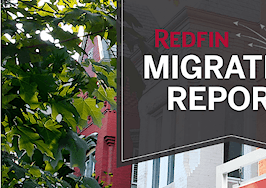- Once millennials get to a certain age and household size, they prefer to live in the suburbs, research shows, and housing development policymakers should take note.
Policymakers for California’s biggest cities are laboring under the delusion that millennials want to live cheek by jowl in the urban core their whole lives. But greater numbers of them are heading for the suburbs than ever before, according to a recent report.
Millennials approaching 30 want a life in the suburbs with good schools nearby and single-family homes like everybody else, said Joel Kotkin, co-author with Wendell Cox of Fading Promise: Millennial Prospects in the Golden State, done in collaboration with the California Association of Realtors’ (C.A.R.) Center for California Real Estate.
Although younger millennials have gravitated toward core cities more than previous generations, as they get older, they actually move to suburban locations more than those their age have in the past, said Kotkin, who is the director of Chapman University’s Center for Demographics & Policy, in the report.

“When they get to their 30s, people don’t want to live in a one-bedroom apartment with four roommates — so don’t address the (housing affordability) problem by creating a product which most people don’t want,” said Kotkin. “Millennials are human beings, too,” he added, speaking at Legislative Week in Sacramento, Tuesday, where he launched the report with Joel Singer, CEO of C.A.R.
Kotkin said there was a popular narrative that millennials reject suburban living, but the statistics tell another story. Since 2010, the growth of the millennial population in the California’s six major metropolitan areas has been concentrated in the suburbs and exurbs (communities beyond the suburbs).
Despite the media reports about millennials settling in the urban core, the largest growth has been on the periphery, he said.
Nationwide, of those under 35 who buy homes, four-fifths choose single-family detached houses. According to a recent National Homebuilders Association report, over 66 percent of millennials, including those living in cities, actually prefer a house in the suburbs.
And more than 80 percent of 25 to 34 year olds in major metropolitan areas already live in suburbs and exurbs, according to Kotkin’s latest data.
Other states benefiting from affordable suburb expansion
It seems that other states are aware of these realities and are building and planning accordingly.
Since 2010, growth in the population of millennials between the ages of 25 and 34 has been greatest in metropolitan areas such as Orlando, Florida; and Austin and San Antonio, Texas; cities without dense urban cores renowned for their decentralized development.

Among the 10 major metropolitan areas with the greatest millennial population growth, all but two have more than 95 percent of their population in suburban or exurban settings, said Kotkin, citing the American City Survey.
California policymakers, by comparison, are not advocating the building of new suburbs but concentrating their efforts on building up the inner cities.
California has the third worst homeownership rate among millennials (25.3 percent) in the country. Homeownership for 25 to 34 year olds is declining faster than the national average — the result of high prices and low incomes among this generation.
“More densification, with a likely shift towards reducing ownership, is being proposed. The 2040 regional plan for the Bay Area calls for 75 percent of new housing development to take place on barely 5 percent of the land mass,” Kotkin said.
The researcher partially blames California’s problems and its concentration on urban development as a solution, on the high profile of San Francisco.
“San Francisco is a wonderful city and atypical — yet it’s got a stranglehold on the state,” he added.
“The idea that people want to live in high density is one of biggest myths, perhaps 10 to 15 percent want to live high density — that’s fine but don’t pretend that is where most of the people are.
“I’ll tell you a dirty little secret, you have to have new housing built on the periphery — that’s what they do in Texas,” he added.

Kotkin is also executive director of the Center for Opportunity Urbanism in Houston.
As a compromise, he suggested doing high density construction but also building on the fringe.
“Then you can decide you want to live in hip, cool district, that’s great, and when you get older then you move out to the fringe,” he said.
While the often-heard argument in California is that there isn’t enough land, that is not true, said Kotkin, who moved to California in 1971.
“California has vast expanses of land, particularly in the state’s interior,” he said in the report. And planners could, as some suggest, develop the kinds of urban amenities, notably town centers, which might be more important to millennials than they were to earlier generations, he added.
Lack of appropriate housing leading to migration
And while little construction happens on the outskirts of California’s big cities, the lack of affordable single-family homes is leading to skilled Californians migrating to other states such as Texas, Arizona, Florida, Georgia and North Carolina.
A recent Urban Land Institute report noted that 74 percent of all Bay Area millennials are considering a move out of the region in the next five years.
California has experienced a net loss in migrants for at least the last 15 years. This includes younger families — those in their late 30s and early 40s, which is the group most likely to leave the state.
These are valuable workers for California, said Kotkin, noting that “the prime market for our economy are the people who are leaving.” And more millennials will follow as they start families.
Kotkin’s suggestion?
“Millennials should force policymakers to abandon the approaches that have diminished their future standard of living. This means reducing barriers to all kinds of new housing, including to family-friendly, single- and multi-family living,” he said.
C.A.R. CEO Joel Singer suggested at the event this week that Realtors sit on planning committees, and to change things “one opinion at a time.”
“California is an incredible place to live, an amazing product to sell, but it’s not to say it can’t be diminished. To innovate is the way to address this,” he said.
Singer said it was worth trying to persuade California-based businesses, instead of going from Silicon Valley to Reno, Nevada, to go from Silicon Valley to Modesto, California.
Those communities are as attractive as those “beating our butt” in San Antonio, he said.








